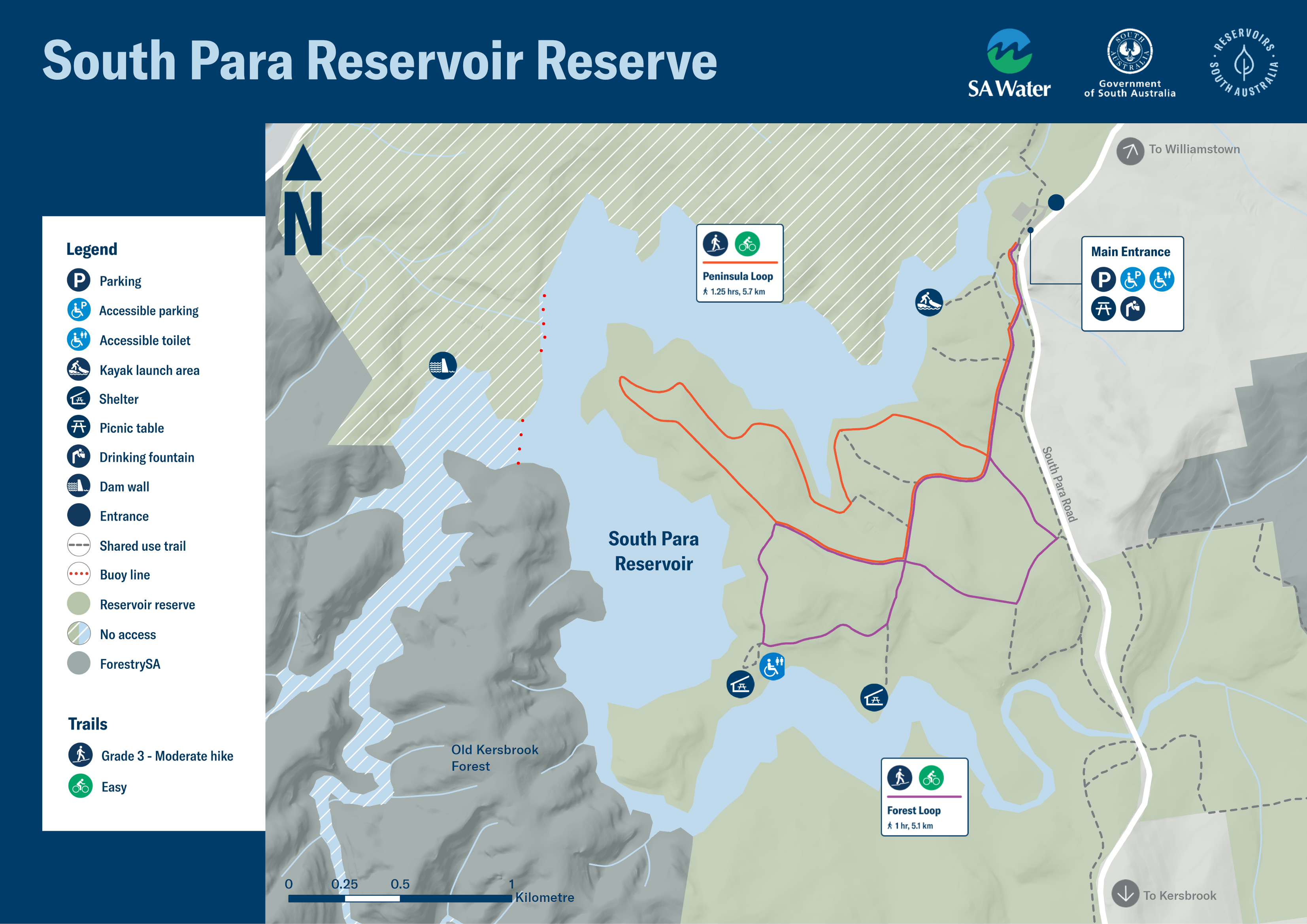South Para
Enjoy, explore, preserve South Para Reservoir Reserve
South Para is the second largest reservoir in South Australia and the surrounding reserve is home to a range of adventure activities. Just minutes drive or a leisurely 30 minute nature walk from Williamstown in the southern Barossa Valley, this reservoir reserve is for outdoor enthusiasts keen to explore a rugged environment.
You can explore the network of trails through the beautiful reservoir surrounds and now linking to Warren Reservoir Reserve and Williamstown in your hiking boots or on your mountain bike. Pack a picnic and make the most of water views deep into the reserve. There is also kayaking/canoeing and fishing along the shore or from your kayak.
Water levels are currently low. Fishing and kayaking are still available, with the nearest accessible water approximately 1km from the car park. Due to these lower than usual water levels, some parts of the shoreline may be steep and slippery or have deep sucking mud. Please take care when fishing or launching a kayak from these areas.

At a glance
 Open 7.30am - 5pm (standard time), 7.30am - 8pm (daylight saving time). Closed on Total Fire Ban Days and for operational activity (gates will be closed).
Open 7.30am - 5pm (standard time), 7.30am - 8pm (daylight saving time). Closed on Total Fire Ban Days and for operational activity (gates will be closed). Car park
Car park Walking/running/hiking
Walking/running/hiking Cycling (mountain biking)
Cycling (mountain biking) Kayaking/canoeing
Kayaking/canoeing Fishing - permit required
Fishing - permit required Picnicking
Picnicking Wildlife and birdwatching
Wildlife and birdwatching No dogs (assistance animals allowed)
No dogs (assistance animals allowed) Accessible toilets
Accessible toilets Automated External Defibrillator
Automated External Defibrillator
Activities and facilities
Before visiting, please check the conditions of access.
 Walking/running/hiking
Walking/running/hiking
With a range of tracks on offer, you can explore on foot through a changing landscape of native bushland and plantation forests. The paths are graded as a moderate hike and are suitable for most ages and fitness levels. There are some steep sections and rough/rocky surfaces.
From the entrance to the north west peninsula is 2.9km, or you can head to the south west peninsula (2.5km) and south peninsula (2.1km). Pack a picnic and explore these shared use trails leading to water views. The reserve boasts a total of 8.7 km of trail.
You can also walk along the reservoir's winding shores, taking in stunning views of the water and lands beyond. Look out for waders, cormorants and pink eared ducks, a rare sight in the Mount Lofty Ranges.
 Fishing
Fishing
With a fishing permit, you can drop a line in the from the shoreline in the public access area or on the water from a kayak or canoe. Be sure to take your insect repellent.
The reservoir is stocked with Murray cod (catch and release), golden perch and silver perch. Fishing limits are detailed on PIRSA's website.
 Cycling
Cycling
The shared use trails offer intermediate mountain biking suitable for riders with a moderate level of skill and fitness. Explore the trails as they pass through a changing landscape of native bushland and plantation forests. You will catch glimpses of the water through the trees before arriving at one of many vantage spots at the water's edge.
 Kayaking/canoeing
Kayaking/canoeing
Choose your experience with a kayak or canoe, from a short meander to a full day's kayaking adventure exploring the twists and turns of this hidden gem from the water.
During the warmer months when the reservoir's level can be low, bring a trolley to get your kayak or canoe to the water's edge more easily.
Suggested routes include:
- to the north west peninsula - 3.6km return, approx. 1.5 hours
- to the south west peninsula - 6.2km return, approx. 3 hours
- to the south peninsula - 10.4km return, approx. 4.5 hours
- to the old bridge - 14km return, approx 6 hours.
Be sure to take your insect repellent.
 Picnicking
Picnicking
The two picnic spots offer a place to sit back and enjoy the water views. Walk, run, ride or kayak to the south west peninsula and the south peninsula for a picnic, with toilets available at the south west peninsula.
![]() With the exception of assistance animals, dogs are not welcome at reservoir reserves as they can carry harmful organisms that can easily contaminate the water and present a risk to the safety of the drinking water. Dogs also pose a threat to local native birds and wildlife.
With the exception of assistance animals, dogs are not welcome at reservoir reserves as they can carry harmful organisms that can easily contaminate the water and present a risk to the safety of the drinking water. Dogs also pose a threat to local native birds and wildlife.
Blue-green algae
Algae is a common occurrence in open water sources, including reservoirs and the River Murray, especially during warmer months of the year when conditions are favourable for growth.
SA Water samplers, operators and scientists actively monitor and test the source water and connecting water networks during these times and adjust treatment processes as needed. This ensures they continue to supply safe, clean drinking water to their customers.
Some blue-green algae species produce compounds which can be harmful to humans and animals. Contact with untreated water in a reservoir where algae are present can be harmful to your health.
When blue-green algae levels are increasing, and related water treatment or algal management activities are being conducted, the site will be closed to visitors until 1pm that day. There will be clear signage at the entrance and on this website page.
To find out more, read SA Health’s information about blue-green algae health impacts and how to avoid illness
Click map and map details below for a print-friendly version.
Extended trail network
Maps on your mobile
If you have a smartphone or tablet you can download the free Avenza Map app and have interactive reservoir reserve maps on hand when you need them.
The app uses your device’s built-in GPS to plot your real-time location within the reserve onto a map. The app can be used without a network connection and without roaming charges. You can also measure area and distance, plot photos and drop placemark pins.
How to get it working on your device:
1. Download the Avenza Maps app from the app store (iOS/Android) whilst you are still in range (its free!).
2. Open up the app and click the shopping cart icon.
3. Click ‘Find’ and type the name of the reservoir reserve you are looking for.
4. Click on the map you are after and install it (all our maps are free).
5. You will now find a list of your installed maps on the home page of the Avenza Maps app.
6. Use our maps through the Avenza Mapa app while in the reserve and never take a wrong turn again.
What sets South Para Reservoir apart
Capacity: 44.8 gigalitres (there are one billion litres in a gigalitre), which would fill Adelaide Oval with water about 90 times
Built: 1949 - 1958
While construction on South Para Reservoir began in 1949, it wasn't finished until 1958 due to the huge demand on funds and resources following the World War II. It was built to support industrial development and population growth in the north of Adelaide in the 1950s. With the establishment of Elizabeth in 1955, the north of Adelaide was booming.
Between 1933 and 1958, annual water consumption in Adelaide increased by 30 per cent, rising from 28,500 million litres to more than 93,000 million litres.
South Para also supported water supply in the Barossa as it fed into the Barossa Reservoir increasing supply to the areas it served.
You can check current reservoir levels at SA Water’s website.
Little known fact about South Para Reservoir
Being constructed after the Second World War, the workforce that built South Para dam was transient and varied. It included married men with young families, single men (largely immigrants who had left Europe after the war), single women who worked in the camp’s canteen, inmates from Yatala Labour Prison, and homeless men from Adelaide who were offered the opportunity of employment.
Water Quality
South Para Reservoir is one of 16 across the state that help supply water to more than 1.7 million South Australians.
Water from South Para flows to Barossa Reservoir where it is treated by SA Water at the water treatment plant onsite before being supplied to 85,000 customers in the Barossa region.
Treating drinking water before it’s supplied to homes, businesses, schools, hospitals and more, is important to make sure it is clean and safe to drink straight from the tap. You can learn how SA Water treats water and maintains the quality its customers value and rely upon.



